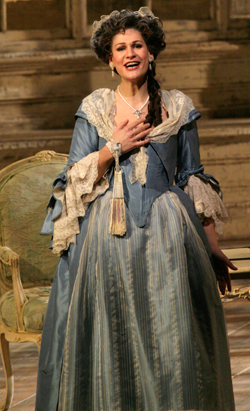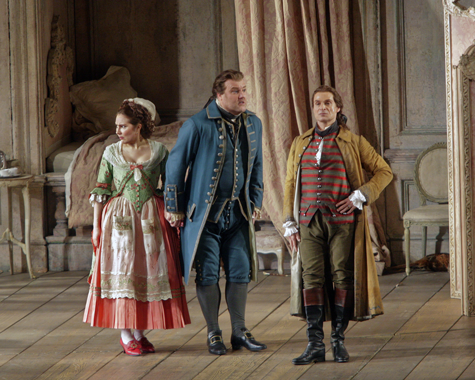Recently in Performances
Anthony Minghella's visually-arresting staging, a co-production with New York's Metropolitan Opera and the Lithuanian National Opera, returned this month to its original home at the London Coliseum after a gap of two years.
While I eagerly seized upon an opportunity to hear Angelika Kirschlager live for the first time, having written in very recent weeks about not one but two of the star mezzo’s current CD releases, I ventured to Frankfurt’s Alte Oper feeling a little bit like her stalker.
When I worked in the Archives of the Met, I was custodian of several hundred costumes, many from the days when divas traveled with steamer trunks full of things run up just for them, by the finest designers, with the most glamorous materials, in the colors and styles that suited the ladies themselves.
There is nothing redeeming about Sir John Falstaff, one of Shakespeare’s most lively comic characters and the subject of Verdi’s final opera, and yet, inexplicably, we love him.
What constitutes an “international opera star” these days, anyway?
The Metropolitan Opera audience loves its Wagner, and the management for the last several decades has, alas, made sure we aren’t spoiled: it’s a rare season that gets more than two production revivals of Wagner, and some years there have been none.
With her performance of the “Four Last Songs,” ably partnered by Michael Tilson Thomas and his San Francisco Symphony, Deborah Voigt emphatically confirmed her place as one of the glories of the current roster of Strauss interpreters.
John Adams, whose opera Nixon in China set the bar for post-minimalism in the lyric theatre, has once again scored a success with his latest work.
Wagner’s all-conquering chic made apocalyptic music-dramas drawn from folklore the ideal of the nationalistic era; every serious opera composer of the time felt obliged to attempt something in that line.
In this country art and politics are rarely bedfellows — strange or otherwise; indeed, it’s seldom that the two meet under the same roof.
Regarded, until the modern vogue for earlier masters, as the senior surviving grand master of opera, Gluck never quite becomes fashionable and never quite vanishes.
There is no middle ground in War and Peace — or, rather, it’s all middle ground, like a battlefield, and you may feel as if every soldier in Russia (and in France) has marched over you.
Once upon a time, we used to only dream about a stellar pairing like Barcelona’s Gran Teatre del Liceu has fielded for their current offering on display: “La Cenerentola.”
Enough ink was spilled last year gushing over Valencia’s new Calatrava-designed opera house and Arts and Science park that I had been chomping at the bit for the opportunity to take in a performance there as soon as my availability and, more important, the availability of a still-very-hard-to-find ticket coincided.
Do we too easily take Richard Strauss for granted? The question is prompted by the superlative production of “Frau ohne Schatten” that was the highlight of the fall season at the Chicago Lyric Opera.
Watching The Queen of Spades staged by a Russian company is often an unforgettable experience.
If Belfast in Northern Ireland isn’t a city that immediately springs to mind as a centre of musical excellence then it’s not for want of talent, initiative and professionalism within its cultural community.
After the triumph of his fifth opera, Ernani, Verdi could have gone on writing howling melodramas and made a mint.
Not long ago, English National Opera declared an intention to capitalise on its name and history by placing greater emphasis on English works.
Despite 19th-century Russia’s reputation as an Italian opera haven, Verdi’s late masterpiece Otello found acceptance there only with great difficulty, even though in its 1889 premiere the title role acquired a great local interpreter in the Mariinsky Theater primo uomo, Nikolai Figner.
Performances
![Ekaterina Siurina (Susanna) and Simon Keenlyside (Count) [Photo copyright Ken Howard courtesy of Metropolitan Opera]](http://www.operatoday.com/Siurina_and_Keenlyside_5666.png)
12 Nov 2007
Le Nozze di Figaro – Metropolitan Opera
Le Nozze di Figaro, in 1786, was the longest and most elaborate opera buffa ever composed and (though it is seldom given complete) is still the longest you are likely to see in the regular repertory.
There are so many
variables that a critic can easily find something to object to. A Countess
short of breath in “Porgi amor,” with which (no warm-up) she opens Act
II; a Cherubino too feminine for adolescent male outpourings; a Count
insufficiently virile for his masculine vanity (the engine that drives the
plot) to be credible; a Marcellina too young to be Figaro’s mother
(Beaumarchais turns Oedipus into farce here, showing how close
tragedy and comedy really are); a lackluster conductor; a “concept”
staging that ignores half the plot; an ugly set; an incompetent fandango or
leap from the window – there is always (as Gilda Radner would say)
something. Attending the Met’s Figaro in a year when few
world-famous names have signed on for it, the manipulator of the poison pen
whets his fangs in malicious anticipation.
At the matinee of November 10, the Met fooled me: until the last two
minutes of the staging (and then it was Jonathan Miller’s unaltered
original direction that let me down, not anything the performers did), Le
Nozze was as near perfect as you are likely to get, and none of those
obvious lapses occurred. Anja Harteros sang both the Countess’s arias
flawlessly and was, in addition, a radiant beauty whose neglect by any
husband puzzled everyone and made him look an oaf. She won the
ovation of the afternoon – even for one who missed the angelic quality Kiri
Te Kanawa brought to the Countess’s final lines of forgiveness. (The opera
– and buffo in general – is primarily about forgiveness for everybody’s
human imperfections – which is why the original, imperial audience found it
easy to overlook the revolutionary subtext.) Ekaterina Siurina, a plump
Russian tidbit, as Susanna sang a radiant “Deh vieni non tardar” and a
“Venite, inginocchiatevi” with the proper giggly bounce. Kate Lindsey is
a real find – her Cherubino looked like an adolescent boy, a very pretty
one to be sure but with an arrogant chin and a “street” sort of strut
that made this cocksure kid a credible threat to the older males. She sang
gloriously too. Marie McLaughlin made an ardent but not preposterous
Marcellina – for once one regretted the omission of her aria – and
Anne-Carolyn Bird, though a bit tall, sang a sweet Barberina.
 Anja Harteros as the Countess
Anja Harteros as the Countess
Among the men, Bryn Terfel naturally stood out in the title role. I did
not like his Figaro when the production was brand new – he seemed so
anxious to show what an actor he was that he huffed and puffed and groaned
and grimaced instead of singing; Mozart took a back seat to Beaumarchais. He
has calmed down considerably over the years, and though still a bouncing
buffo-man with plenty of time for comedy (if his pretence of jumping off the
balcony is not quite believable), he now sings the arias at a less frenetic
pace, with more of the elegance they require and reward. Simon Keenlyside
played the Count as an elegant fop, forever tossing his curls and pratfalling
on the polished floors, but this never interfered with his musical authority.
Maurizio Murano’s blowhard Bartolo, Greg Fedderly’s slithy Basilio, and
Patrick Carfizzi’s lumpish Antonio earned most of the day’s laughs.
Philippe Jordan is a young Swiss who conducts with zest and delight, as if
he wanted to grab you by the ears and prove this is a masterpiece with charms
you never suspected – hardly necessary with Figaro, but what I
mean is, he takes none of it for granted, he is thrilled by the music and
eager to share.
 Ekaterina Siurina (Susanna), Bryn Terfel (Figaro) and Simon Keenlyside (Count)
Ekaterina Siurina (Susanna), Bryn Terfel (Figaro) and Simon Keenlyside (Count)
And what did I object to about the conclusion? In the Met’s rush to get
the Countess into a new and glittery gown for the finale, no one has thought
(and Mr. Miller years ago did not think) to have her show the ring to the
Count, revealing to him that she is the mysterious lady he made love to in
the dark. The audience knows this, and Figaro and Susanna know it, but the
Count does not, and his heartfelt, aristocratic apology is inexplicable if he
doesn’t. The laws of farce are immutable: If you do not tie all the knots,
the machine unravels. It’s such an easy piece of business to fix – and so
satisfying when it’s fixed. Patch it up, Met.
John Yohalem
![Ekaterina Siurina (Susanna) and Simon Keenlyside (Count) [Photo copyright Ken Howard courtesy of Metropolitan Opera]](http://www.operatoday.com/Siurina_and_Keenlyside_5666.png)

